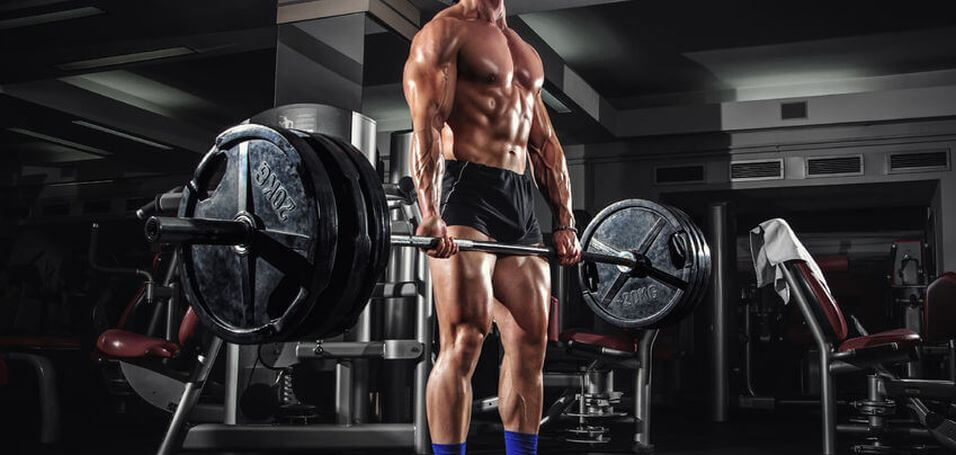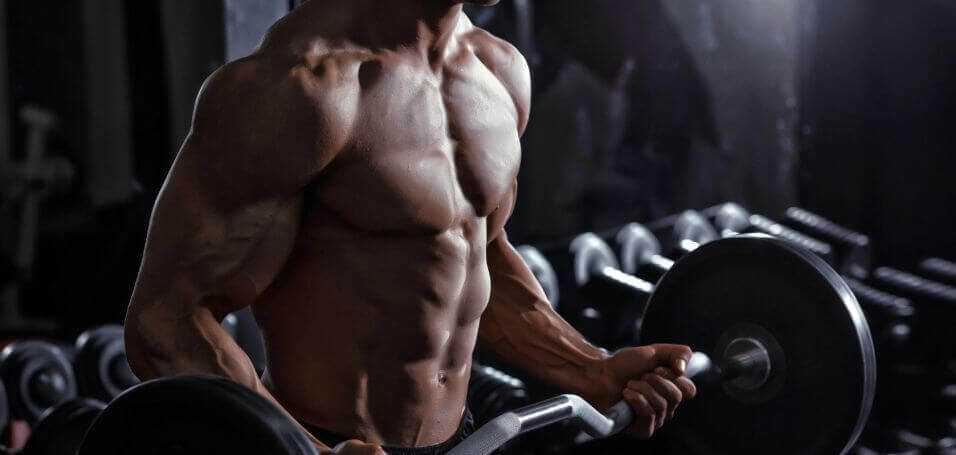Spend enough time in the gym and you’ll inevitably notice that the biggest guys and gals are also often the strongest.
Sure, some people are stronger than they look, but for the most part, strength and size seem to be directly correlated.
The bigger someone is, the bigger his weights tend to be.
This begs a question, then:
Is muscle growth simply a byproduct of strength? If you just focus on getting stronger and stronger, will your muscles just get bigger and bigger?
Advocates of strength training have been saying this for decades, but their detractors say that muscle growth isn’t that simple.
They point to stringbeans that can push, pull, and squat tremendous amounts of weight, and to research that appears to demonstrate that heavy weightlifting–the bread and butter of all strength programs–simply isn’t necessary for getting big muscles.
Instead, they counter, you can focus on other training variables, such as volume, time under tension, metabolic fatigue, and others, and achieve the same results.
Who’s right? Or are both of these schools of thought misguided and the truth is somewhere in the middle?
Well, in this article, you’re going to get a clear, concise, and conclusive answer based on decades of anecdotal evidence as well as our current scientific understanding of muscle hypertrophy.
And here’s the long story short:
The most reliable way to gain muscle is indeed getting stronger.
As you’ll soon see, there’s absolutely a direct relationship between strength and muscle size, but there’s also more to the story, and it explains why some people are much stronger than they look (and vice versa) and why some people can gain significant amounts of muscle without ever paying attention to their one-rep maxes.
So, let’s start by setting the table with a bit of muscle growth 101, and then see how it relates to strength.
- What Makes Muscles Grow?
- What About People That Get Big But Not Strong?
- What About People That Are Way Stronger Than They Look?
- Don’t You Eventually Stop Gaining Strength, Though?
- What to Do When It Gets Really Hard to Get Stronger
- The Bottom Line on Getting Bigger and Stronger
Table of Contents
+Want to listen to more stuff like this? Check out my podcast!
What Makes Muscles Grow?
Despite what the bodybuilding mags might tell you, the primary driver of muscle growth isn’t muscle confusion or soreness, “metabolic conditioning,” time under tension, or anything other than this:
This refers to increasing tension levels in the muscle fibers over time, and the most effective way to do it is progressively increasing the amount of weight that you’re lifting.
In other words, if you’re not gradually adding weight to the bar over time, you’re missing out on most of what progressive overload has to offer.
Another driver of muscle growth is muscle damage, which refers to just that: the physical damage caused to muscle fibers by high levels of tension.
This damage must be repaired, of course, and if you eat right and give your body sufficient rest, then the damaged fibers can be made bigger and stronger to better deal with future training bouts (tension).
A third factor is metabolic stress, which refers to working muscle fibers to their metabolic limits through the repetition of actions to muscular failure.
You can think of these as muscle growth “pathways,” and they can be emphasized or de-emphasized or lessened by how you train.
For example, heavy weightlifting emphasizes progressive tension overload and muscle damage. Working with lighter weights and higher rep ranges, however, emphasizes metabolic stress (and especially when the rest times in between sets are relatively short).
So, if progressive overload is the most powerful stimulus for muscle growth…
…and if adding weight to the bar is the best way to achieve progressive overload…
…then what’s the best way to build muscle?
Yup, it’s gaining strength.
That’s why your number one goal as a natural weightlifter should be increasing your whole-body strength.
That isn’t to say that lighter weights and other training modalities have no place in your workout routine, but if your goal is to gain muscle as quickly as possible, then, ultimately, you need to gain strength as quickly as possible.
It’s that simple.
Now, we could end the discussion here, but chances are you have doubts because you’ve heard about or seen evidence to the contrary, indicating that strength and size aren’t as connected as I’m claiming they are.
Let’s tackle a few of the most common rebuttals.
What About People That Get Big But Not Strong?

Raise your hand if you’ve seen this before:
Some guy or gal starts hitting the weights and quickly adds a considerable amount of size without ever giving a second thought to progressive overload.
They just run from one isolation exercise to another chasing a pump and grow, grow, grow.
What gives?
Well, the first thing you need to know is when you first subject your body to any form of resistance training, it’s hyper-responsive to the stimulus.
During this honeymoon period, even the most poorly designed workout programs can produce noticeable changes in your physique.
That’s why research shows that when you’re new to resistance training, getting stronger does produce muscle growth, but you don’t have to gain much strength to gain size.
In short, you can more or less ignore progressive overload for your first six months or so and go about your training willy-nilly and have something to show for it.
After that, though, the game changes. Radically.
Once your “newbie gains” have been exhausted, studies show that muscle growth is going to skid to a halt if you don’t get serious about getting stronger.
This is where progressive overload must become the focus of your training if you want to keep your muscles growing, and, as you know, the best way to do that is to add weight to the bar over time, and especially on compound exercises like the squat, deadlift, and bench press.
If you’ve never touched a barbell or struggled to lift a weight over 70% of your one-rep max, this shift can be jarring. Workouts get really hard, really fast.
That’s one of the reasons why I recommend that people focus on building whole-body strength from the get-go.
This way they’ll enjoy the newbie gains but also prepare themselves mentally and physically for what’s to come, when muscle is much harder to come by. They’ll have their technique dialed in on their primary movements and will be able to handle heavy loads safely and comfortably.
Look at it this way:
Unless your goals for your physique are very modest, you’re going to have to eventually focus on getting really strong, so why not get a head start?
What About People That Are Way Stronger Than They Look?

We’ve all seen this before, and it can certainly boggle the mind.
There are plenty of men and women out there who can lift more weight than people twice their size and make it look easy.
Case in point:
187 pounds and benching 451 pounds?? WTF? Most guys well north of 200 pounds dream of being able to put weight like that up on the bench.
Feats like this raise questions about how much strength and size are really associated, and rightly so.
What are we looking at here?
Steroids? Higher levels of muscle activation? Flawless technique?
Sure, these can be factors, but the most important one is something most people don’t consider:
Anatomy.
While we all have the same muscles in our bodies and they’re all located in the same general regions, there are differences in how they’re attached to our skeletons.
These discrepancies are usually small–only a centimeter or two–but they can translate into huge differences in natural strength.
We don’t need to get too technical for the purposes of this discussion, but what it boils down to is mechanical advantage.
Because muscles function as levers, where they attach to your bones greatly impacts how much force they’re able to produce and thus how much weight they’re able to move.
The effects here are staggering, too.
Studies have found that, thanks to anatomical variance, strength can vary by as much as 25% among people with identical amounts of lean mass.
In other words, one person can be up to 25% stronger than another with the same body composition.
Similarly, some people’s muscles and bones are arranged in a way that allows them to lift far more than you’d expect based on their total lean mass. For example, if someone has short biceps, they have a major advantage on the bench press (the bar doesn’t have to move as far), and if someone has long arms and short legs, they’re going to be particularly good at deadlifting.
In other words, some people are just born to push, pull, and squat tremendous amounts of weight, and some aren’t.
C’est la vie. 😉
Now, if you’re worried that you’re in the latter camp, take heart because all this should only seriously concern you if you’re trying to become a competitive strength athlete.
If you’re in the gym to build a strong, muscular, lean, and healthy body, though, then you can achieve your goal with or without a genetic leg up.
Don’t You Eventually Stop Gaining Strength, Though?

It goes without saying that you can’t keep adding weight to the bar forever.
Eventually, you’ll hit your ceiling for whole-body strength and have little to no room left to grow your one-rep maxes.
Fortunately, this isn’t something to be concerned with for two reasons:
- It takes at least 10 to 15 years of high-quality training to get there, and most people never do.
- If you ever do breathe that rarefied air, you’re going to be pretty freakin’ huge.
To the first point, many people think they’ve reached their strength potential but are far from it. Instead, they’re just training incorrectly.
Something I often seen among this crowd is far exceeding the body’s ability to fully recover from training.
Many train 5, 6, even 7 days per week, put tremendous amounts of strain on their muscles, joints, and nervous systems, eat too few calories and nutritious foods, rarely deload if ever, and the like.
To the second point, as you now know, once you’ve graduated to the intermediate stage of weightlifting, muscle growth and strength become inextricably linked.
Thus, if you put in years of hard work to significantly increase your whole-body strength, you’re also going to significant increase your whole-body muscularity.
Now, if you were to do that and feel like you’re still not big enough, well, that’s where you’d want to consider getting on the #dedication.
So, the bottom line is this:
If you’re like most people, you can get the body you really want by simply getting really strong.
What to Do When It Gets Really Hard to Get Stronger

When you’re new to weightlifting, you can add weight to the bar just about every week.
It’s glorious.
It also eventually comes to an end, and soon enough, you’re fighting tooth and nail just to gain reps.
This is a critical period in your progression as a weightlifter, and the wrong thing to do is abandon your quest to get stronger and turn to nonsense like muscle confusion, “super slow training,” and other fads in hopes of easier muscle gains.
Instead, you need to fine tune your training methodology.
First, I mentioned this earlier but it bears repeating: you need to make sure you’re incorporating deloads into your routine.
This boils down reducing the amount of weight and/or reps that you’re working with for a week or so, which buys your body additional time to recuperate and prepare for another period of intense overload.
As a beginner, you can go for months without ever feeling the need to deload, but after many years of regular training, you may need to deload as often as every 4 to 8 weeks, depending on your genetics and workout program.
(I personally deload every 6 to 8 weeks.)
Second, you should know that progression does eventually become a non-linear grind.
This is true even when you’re doing everything right.
It’s very common to reach a point where you can only add 2.5 pounds to the bar every other week on just a few of your lifts, and for others to just freeze for several months.
The reason for is this as you get closer and closer to your genetic potential for strength and muscularity, you have to work harder and harder to keep the needle moving.
That, though, is the solution: keep working hard.
If you keep putting in high-quality work in the gym and attending to your diet and recovery accordingly, you’ll eventually make breakthroughs and reach new plateaus that you then have to endure and break through in turn.
It’s not entirely clear why this happens, but it probably has to do with changes in your daily stress levels, sleep, and other variables involved in adaptation to exercise.
Third, periodically increase the number of heavy sets that you do in your workouts.
Studies show that intermittently increasing high-intensity (load) volume is an effective way to increase progressive overload and thereby boost muscle growth.
This is especially useful for the purposes of correcting muscle imbalances and “weak points” in your physique.
For instance, if your quads aren’t growing as much as you’d like, you may need to blitz your legs to “force” them to grow, and the same goes for all other major muscle groups like your back, shoulders, butt, biceps, and triceps.
The Bottom Line on Getting Bigger and Stronger
When you’re a weightlifting newbie, you can gain muscle and strength with even the worst of workout programs.
You almost can’t go wrong.
Those halcyon days are far too short, though, and eventually you have to face the fact that what got you your newbie gains won’t necessarily get you any further.
That doesn’t mean you have to get stuck in a rut, though.
You just have to make sure your diet is dialed in, work a bit smarter and harder in the gym, stay patient, and focus on maximizing progressive overload through planned periods of overreaching and deloading, and you can continue gaining muscle for years to come.
Happy training!
What’s your take on getting bigger and stronger? Have anything else you’d like to share? Let me know in the comments below!
Scientific References +
- BJ, S., D, O., & JW, K. (2017). Dose-response relationship between weekly resistance training volume and increases in muscle mass: A systematic review and meta-analysis. Journal of Sports Sciences, 35(11), 1073–1082. https://doi.org/10.1080/02640414.2016.1210197
- SL, D., & W, M. (1993). Effects of hip center location on the moment-generating capacity of the muscles. Journal of Biomechanics, 26(4–5), 485–499. https://doi.org/10.1016/0021-9290(93)90011-3
- Trezise, J., Collier, N., & Blazevich, A. J. (2016). Anatomical and neuromuscular variables strongly predict maximum knee extension torque in healthy men. European Journal of Applied Physiology 2016 116:6, 116(6), 1159–1177. https://doi.org/10.1007/S00421-016-3352-8
- Appleby, B., Newton, R. U., & Cormie, P. (2012). Changes in strength over a 2-year period in professional Rugby Union players. Journal of Strength and Conditioning Research, 26(9), 2538–2546. https://doi.org/10.1519/JSC.0B013E31823F8B86
- Baker, D., Wilson, G., & Carlyon, R. (n.d.). Periodization: The Effect on Strength of Manipulating Volume... : The Journal of Strength & Conditioning Research. Retrieved August 13, 2021, from https://journals.lww.com/nsca-jscr/Abstract/1994/11000/Periodization__The_Effect_on_Strength_of.6.aspx
- Ahtiainen, J. P., Walker, S., Peltonen, H., Holviala, J., Sillanpää, E., Karavirta, L., Sallinen, J., Mikkola, J., Valkeinen, H., Mero, A., Hulmi, J. J., & Häkkinen, K. (2016). Heterogeneity in resistance training-induced muscle strength and mass responses in men and women of different ages. AGE 2016 38:1, 38(1), 1–13. https://doi.org/10.1007/S11357-015-9870-1
- PJ, A., J, J., PA, L., AW, T., & RE, T. (1994). Acute and chronic response of skeletal muscle to resistance exercise. Sports Medicine (Auckland, N.Z.), 17(1), 22–38. https://doi.org/10.2165/00007256-199417010-00003
- A L Goldberg, J D Etlinger, D F Goldspink, & C Jablecki. (n.d.). Mechanism of work-induced hypertrophy of skeletal muscle - PubMed. Retrieved August 13, 2021, from https://pubmed.ncbi.nlm.nih.gov/128681/
- Morton, R. W., Oikawa, S. Y., Wavell, C. G., Mazara, N., McGlory, C., Quadrilatero, J., Baechler, B. L., Baker, S. K., & Phillips, S. M. (2016). Neither load nor systemic hormones determine resistance training-mediated hypertrophy or strength gains in resistance-trained young men. Journal of Applied Physiology, 121(1), 129–138. https://doi.org/10.1152/JAPPLPHYSIOL.00154.2016










